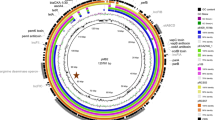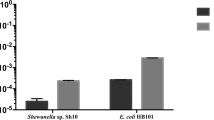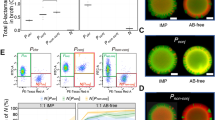Abstract
RESISTANCE to various antibiotics is common in the anaerobic gut bacterium Bacteroides fragilis. A transferable plasmid coding for resistance to antibiotics of the lincosamide/macrol-ide/synergistin groups has been found1,2 and transfer is most probably a conjugative process. This supports the observation of the recent emergence of resistance to antibiotics in these groups and its rapid spread in certain areas (ref. 3 and our unpublished data). However, in the case of tetracycline resistance the limited genetic and physical data were at variance with the epidemiological data. Although tetracycline resistance is common in B. fragilis4 (at present 60% of strains isolated in the USA5 and 30% of those isolated in France (our unpublished results) are resistant) intraspecies transfer of tetracycline resistance could not be demonstrated6. We report here that transfer of tetracycline resistance between B. fragilis strains is easily achieved if the donor bacteria are grown in the presence of tetracycline before mating. This suggests that tetracycline resistance is borne on a transferable plasmid whose conjugative transfer requires activation of the tetracycline resistance gene. This is supported by our finding that the transfer of tetracycline resistance is either inducible or constitutive, depending on whether tetracycline resistance itself is respectively inducible by tetracycline or constitutive.
This is a preview of subscription content, access via your institution
Access options
Subscribe to this journal
Receive 51 print issues and online access
$199.00 per year
only $3.90 per issue
Buy this article
- Purchase on Springer Link
- Instant access to full article PDF
Prices may be subject to local taxes which are calculated during checkout
Similar content being viewed by others
References
Privitera, G., Dublanchet, A. & Sebald, M. J. inf. Dis. 139, 97–101 (1979).
Welch, R. A., Jones, K. R. & Macrina, F. L. Plasmid (in the press).
Rozmiej, E. A., Bawdon, R. E., Palchaudhuri, S. & Krakowiak, J. 18th. Intersci. Conf. Antimicr. Ag. and Chemother., Atlanta, abstr. 86 (1978).
Suttler, V. L., Kwok, Y. Y. & Finegold, S. M. in Anaerobic Bacteria: Role in Disease (eds Balows, A., Dehaan, R. M., Dowell, V. R. & Guze, L. B.)(Charles Thomas, Springfield, 1972).
Finegold, S. M. in Anaerobic Bacteria in Human Disease (ed. Finegold, S. M.) (Academic, New York, 1977).
Guiney, D. G. & Davis, C. E. J. Bact. 124, 503–510 (1975).
Yang, H. L., Zubay, G. & Levy, S. B. Proc. natn. Acad. Sci. U.S.A. 73, 1509–1512 (1976).
Nakazawa, T. & Yokota, T. J. Bact. 129, 39–46 (1977).
Petit, A. et al. Nature 271, 570–572 (1978).
Author information
Authors and Affiliations
Rights and permissions
About this article
Cite this article
PRIVITERA, G., SEBALD, M. & FAYOLLE, F. Common regulatory mechanism of expression and conjugative ability of a tetracycline resistance plasmid in Bacteroides fragilis. Nature 278, 657–659 (1979). https://doi.org/10.1038/278657a0
Received:
Accepted:
Published:
Issue Date:
DOI: https://doi.org/10.1038/278657a0
This article is cited by
-
Transposon-like structures in the Bacteriodes fragilis MLS plasmid pIP 410
Molecular and General Genetics MGG (1981)
Comments
By submitting a comment you agree to abide by our Terms and Community Guidelines. If you find something abusive or that does not comply with our terms or guidelines please flag it as inappropriate.



